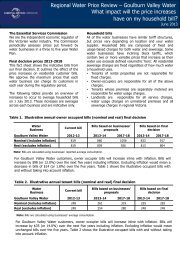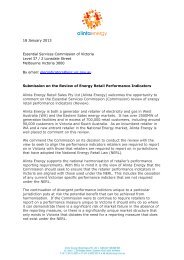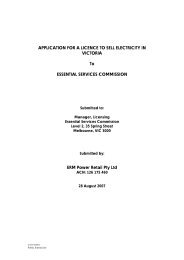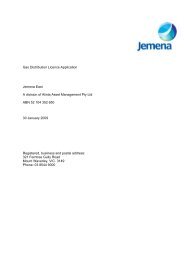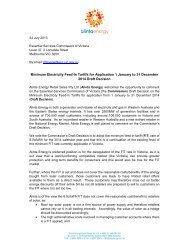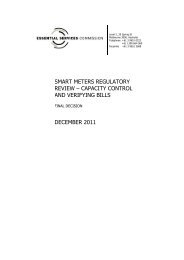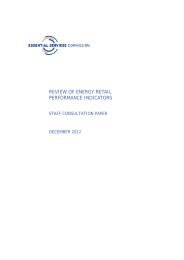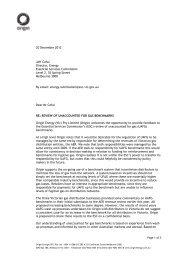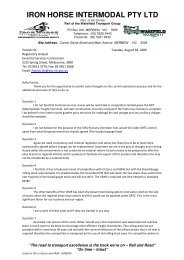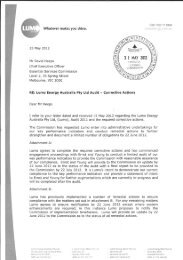SP Ausnet - Essential Services Commission
SP Ausnet - Essential Services Commission
SP Ausnet - Essential Services Commission
You also want an ePaper? Increase the reach of your titles
YUMPU automatically turns print PDFs into web optimized ePapers that Google loves.
clear what additional uncertainty setting the benchmark at the blended rate would<br />
cause.<br />
Mechanisms for calculating a ‘blended benchmark’<br />
To provide equity, due to the delay in publishing the revised UAFG benchmarks, an<br />
adjustment is made to the part year 2013 (i.e. Jul to Dec) benchmark so that the<br />
weighted average benchmark for the full calendar year remains consistent with the<br />
ESCV Final Decision on UAFG benchmarks (i.e. 5.4% within the Draft Decision).<br />
The simplest approach to setting a blended benchmark is an adjustment based on<br />
the number of days each benchmark would apply. The following formulae shows the<br />
calculation of the pro-rata benchmark based of the full calendar year benchmark<br />
provided for in the Final Decision.<br />
B CY = Full Calendar Year Class B Benchmark as per ESC - Final Decision<br />
B 1 = Interim 2013 <strong>SP</strong> AusNet Class B Benchmark (Victoria Government Gazette No. S 460)<br />
B 2 = Adjusted 2013 <strong>SP</strong> AusNet Class B Benchmark<br />
D 1 = Period in days that the Benchmarks provided for in Gazette S 460 was applied over.<br />
The following example provides a final adjusted benchmark that would be declared in<br />
the amended Schedule 1, Part C Unaccounted For Gas of the GDSC for the period<br />
remaining in the 2013 calendar year post the final decision on UAFG benchmarks.<br />
B CY = 5.4% as per the ESC Draft Decision – <strong>SP</strong> AusNet 2013 Class B Benchmark<br />
B 1 = 4.9% as per the Victoria Government Gazette No. S 460 - <strong>SP</strong> AusNet 2013 Class B<br />
Benchmark<br />
B 2 = Final adjusted 2013 <strong>SP</strong> AusNet Class B Benchmark<br />
D 1 = 181 days based on the period from 1 January 2013 to 30 June 2013 (proposed GDSC<br />
amended effective 1 July 2013).<br />
A slightly more sophisticated approach to setting the blended benchmark would be to<br />
base it on historical gas consumption patterns. The formula shows how this could<br />
work using data from a nominated ‘benchmark year’, although this could also be<br />
done using historical averages.<br />
Page 6



